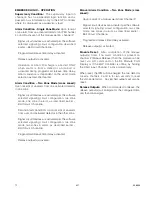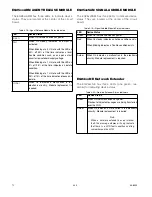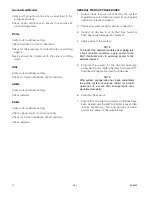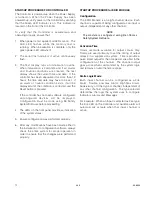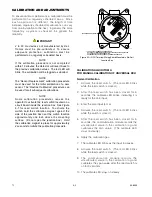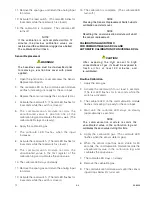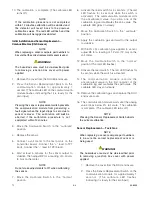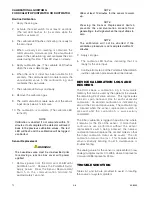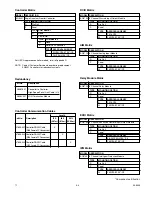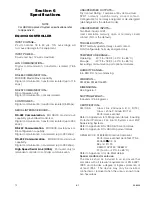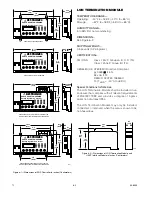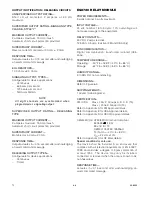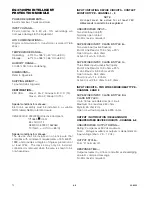
7.1
95-8533
5-5
NOTE
Pressing the Sensor Replacement Switch
prevents the communication module from
generating a fault signal when the input drops to
zero due to sensor removal. The calibration will
not
be aborted if the calibration procedure is not
completed within 12 minutes.
3. Replace the sensor.
4. Wait at least 5 minutes for the sensor output to
stabilize.
5. Activate the reed switch. (The red LED flashes for
3 seconds while the switch is activated.) The
communication module records the uncalibrated
value in position one of the calibration log and
calibrates the zero value. (The calibrate LED
stays on steady.)
6. Apply the calibration gas. (The calibrate LED
flashes when the input increases.)
7. Activate the reed switch. (The red LED flashes for
3 seconds while the switch is activated.)
8. The communication module records the
uncalibrated value in the first register of the
calibration log and calibrates the span value. (The
calibrate LED stays on steady.)
9. Remove the calibration gas and replace the DCU
enclosure cover.
10. The communication module waits until the analog
value drops below 4% full scale. The calibration
is complete. (The calibrate LED turns off.)
NOTE
Pressing the Sensor Replacement Switch aborts
the calibration and starts over.
CALIBRATION ALGORITHM D
FOR UNIVERSAL DCUs wITH O2 SENSOR
Normal Calibration
1. Apply clean air (20.9% oxygen).
2. Activate the reed switch for at least 4 seconds.
(The red LED flashes for 3 seconds while the
switch is closed.)
3. The calibrate LED flashes, indicating calibration
has begun.
4. The communication module waits 3 seconds.
5. The communication module records the
uncalibrated value in the calibration log and
calibrates the span value.
6. The calibrate LED stays on steady.
7. The communication module waits 3 seconds.
8. Calibration is complete. (The calibrate LED turns
off.)
Sensor Replacement
wARNING!
The hazardous area must be de-classified prior
to removing a junction box cover with power
applied.
1. Open the junction box cover and press the Sensor
Replacement Switch.
2. The calibrate LED on the communication module
flashes, indicating it is ready for the zero input.
3. Replace the sensor and set the Sensor Switch
(located on the sensor cell) to zero.
4. Activate the reed switch. (The red LED flashes for
3 seconds while the switch is closed.)
5. The communication module records the
uncalibrated value in position one of the
calibration log and calibrates the zero value. The
calibrate LED stays on steady.
6. Set the Zero Switch on the sensor to the “normal”
position. Apply clean air (20.9% oxygen) to set
the sensor analog span value.
7. The calibrate LED flashes when the input goes
high.
8. Activate the reed switch. (The red LED flashes for
3 seconds while the switch is closed.)
9. The communication module records the
uncalibrated value in the first register of the
calibration log and calibrates the span value.
10. The calibration is complete. The calibrate LED
turns off.
NOTE
Pressing the sensor replacement switch aborts
the calibration.
Summary of Contents for DET-TRONICS 95-8533
Page 128: ...7 1 95 8533 A 4 Figure A 1 System Drawing 007545 001 ...
Page 129: ...95 8533 A 5 7 1 Figure A 2 System Drawing 007545 001 ...
Page 131: ...95 8533 7 1 B 2 Figure B 1 Drawing 007546 001 ...
Page 132: ...95 8533 7 1 B 3 Figure B 2 Drawing 007546 001 ...
Page 134: ...95 8533 7 1 C 2 Figure C 1 Drawing 007547 001 ...
Page 141: ...95 8533 7 1 D 7 Figure D1 System Drawing 007545 001 ...
Page 143: ...APPENDIX E E 1 95 8533 7 1 ...


